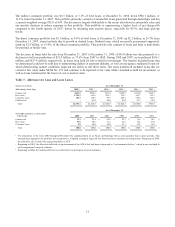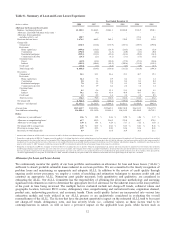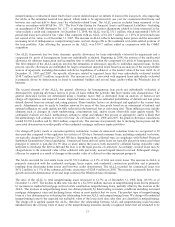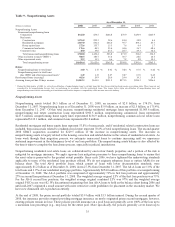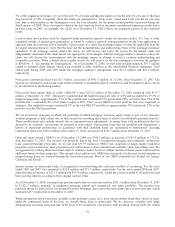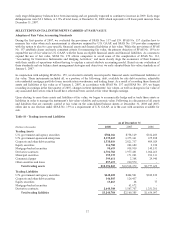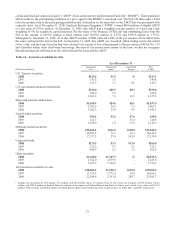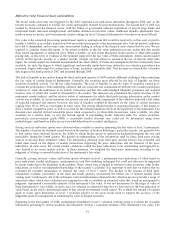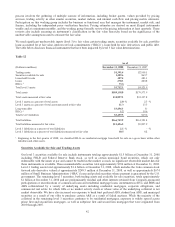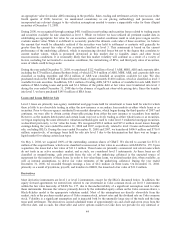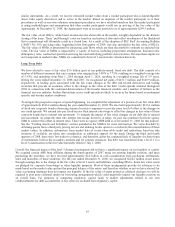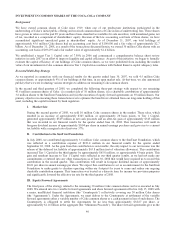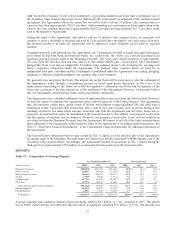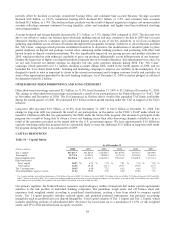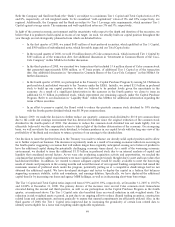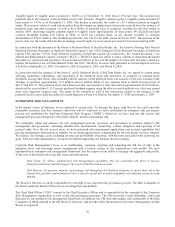SunTrust 2008 Annual Report Download - page 53
Download and view the complete annual report
Please find page 53 of the 2008 SunTrust annual report below. You can navigate through the pages in the report by either clicking on the pages listed below, or by using the keyword search tool below to find specific information within the annual report.Difficult to Value Financial Assets and Liabilities
The broad credit crisis that was triggered by the 2007 subprime loan melt-down intensified throughout 2008 and, as the
broader economy continued to worsen, the credit and liquidity markets became dysfunctional. The second half of 2008 was
marked by turmoil in the financial sector, with the failure or government induced acquisitions of several large banks and
investment banks, increased unemployment, and further declines in real estate values. Additional liquidity adjustments were
made on many securities, and wider spreads caused valuing our level 3 financial instruments to become even more difficult.
Fair value is the estimated price using market-based inputs or assumptions that would be received to sell an asset or paid to
transfer a liability in an orderly transaction between market participants at the measurement date. Current market conditions
have led to diminished, and in some cases, non-existent trading in certain of the financial asset classes that we own. We are
required to consider observable inputs, to the extent available, in the fair value estimation process, unless that data results
from forced liquidations or distressed sales. When available, we will obtain third party broker quotes or observable market
pricing data, as this level of evidence is the strongest support for the fair value of these instruments, absent current market
activity in that specific security or a similar security. Despite our best efforts to maximize the use of relevant observable
inputs, the current market environment has diminished the observability of trades and assumptions that have historically been
available. As such, the degree to which significant unobservable inputs have been utilized in our valuation procedures has
increased, largely with respect to certain types of loans, securities, and public debt. This decrease in observability of market
data began in the third quarter of 2007 and persisted through 2008.
The lack of liquidity in the market during the third and fourth quarters of 2008 created additional challenges when estimating
the fair value of certain financial instruments. Generally, the securities most affected by the lack of liquidity are those
securities classified as level 3 in the fair value hierarchy. The lack of liquidity in specific types of securities caused us to
evaluate the performance of the underlying collateral and use a discount rate commensurate with the rate a market participant
would use to value the instrument in an orderly transaction and that also acknowledged illiquidity premiums and required
investor rates of return that would be demanded in the market. The discount rate considered the capital structure of the
instrument, market indices, and the relative yields of instruments for which third party pricing information and/or market
activity was available. In certain instances, the interest rate and credit risk components of the valuation indicated a full return
of expected principal and interest; however, the lack of liquidity resulted in discounts on the value of certain securities
ranging from 5% to 40% or even higher in some cases. The current illiquid market is requiring discounts of this degree to
drive a market competitive yield, as well as account for the extended duration risk from the repayment of the instrument. The
discount rates selected derived reasonable prices when compared to (i) observable transactions, when available, (ii) other
securities on a relative basis, or (iii) the bid/ask spread of non-binding broker indicative bids. For certain securities,
particularly non-investment grade MBS, a reasonable market discount rate could not be determined using those
methodologies, and therefore dollar prices were established based on market intelligence.
Pricing services and broker quotes were obtained when available to assist in estimating the fair value of level 3 instruments.
The number of quotes we obtained varied based on the number of brokers following a particular security, but generally two
to four quotes were obtained; however, the ability to obtain broker quotes or indications declined throughout the year and
particularly during the fourth quarter. We gained an understanding of the information used by these third party pricing
sources to develop these estimated values. The information obtained from third party pricing sources was evaluated and
relied upon based on the degree of market transactions supporting the price indications and the firmness of the price
indications. In most cases, the current market conditions caused the price indications to be non-binding and supported by
very limited to no recent market activity. In those instances, we weighted the third party information according to our
judgment of it being a reasonable indication of the instrument’s fair value.
Generally, pricing services’ values and broker quotes obtained on level 3 instruments were indications of value based on
price indications, market intelligence, and proprietary cash flow modeling techniques but could not otherwise be supported
by recent trades due to the illiquidity in the markets. These values were evaluated in relation to other securities, other broker
indications, as well as our independent knowledge of the security’s collateral. It is important to note that we believe that we
evaluated all available information to estimate the value of level 3 assets. The decline in the amount of third party
information available, particularly in the third and fourth quarters, necessitated the further use of internal models when
valuing level 3 instruments. All of the techniques used and information obtained in the valuation process provides a range of
estimated values, which were evaluated and compared in order to establish an estimated value that, based on management’s
judgment, represented a reasonable estimate of the instrument’s fair value. It was not uncommon for the range of value of
these instruments to vary widely; in such cases, we selected an estimated value that we believed was the best indication of
value based on the yield a market participant in this current environment would expect. We evaluate the amount of realized
gains or losses upon disposition of level 3 securities relative to our most recent mark to support the accuracy of the
judgments made by management in estimating the value of illiquid securities.
Beginning in the first quarter of 2008, management established a level 3 valuation working group to evaluate the available
information pertaining to certain securities and ultimately develop a consensus estimate of the instrument’s fair value. The
41


